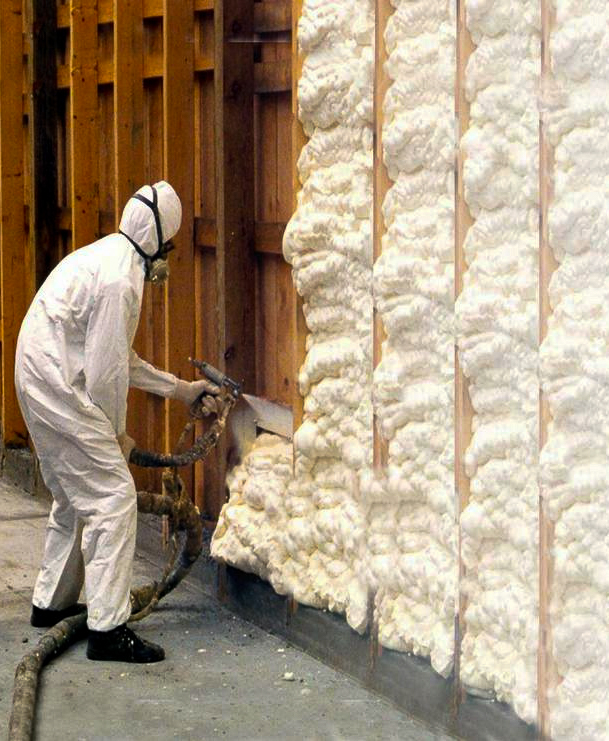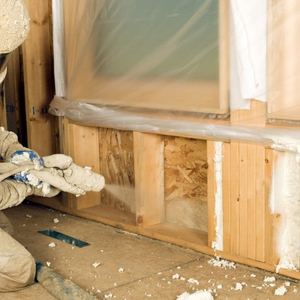
Image Credit: Dunktanktechnician / CC BY 2.0 / Flickr
Green Seal Inc., a nonprofit certifier of green building products, has published a green standard for insulation, giving builders and homeowners the most comprehensive guide to date for choosing products with the lowest potential to damage human health and the environment.
In a recent statement, Green Seal said that its Architectural Insulation Standard (GS-54) sets “challenging yet achievable requirements” for the country’s insulation industry. It covers a variety of health and environmental concerns and sets benchmarks for the global warming impact of blowing agents, the presence of toxic chemicals, the amount of recycled content, and even installation and packaging.
“It is designed to make it easier for the market to identify green insulation products that work and protect human as well as environmental health,” a statement posted at the group’s website says.
The standard covers all types of insulation used in both residential and commercial projects: fiberglass, rock wool, polyurethane, polystyrene, polyisocyanurate, cellulose, denim, vermiculite, perlite, and animal wool. It doesn’t cover polyurethane sold in containers of less than 55-gallon drums (exempting canned foam used to seal gaps around windows, for example); nor does it extend to a variety of specialized insulation materials used in such things as ovens, cars, and airplanes.
In writing new rules on what makes a particular insulation environmentally superior, Green Seal also made some compromises by exempting certain chemicals that don’t have a commercially available substitute. The final language on spray polyurethane foam is especially troubling to environmental activists.
What the standard requires
Green Seal says that its new certification requirements are the most comprehensive and up-to-date for the U.S. market. (Green Seal also has produced a summary of the requirements.) Here are some of the benchmarks:
Global warming potential. The blowing agents used to make foam insulation must have a global warming potential (GWP) of no more than 25 — meaning that it’s no more than 25 times as potent a greenhouse gas as carbon dioxide. However, the standard exempts blowing agents now used in extruded polystyrene insulation, allowing those compounds to have a GWP of up to 1500 until January 2019. Most manufacturers now use hydrofluorocarbons (HFCs) to make XPS. They have been testing an alternative, a hydrofluoro-olefin (HFO) with a GWP of less than 1 in anticipation of a government ban on HFCs coming up in 2021, but have resisted calls for an earlier transition.
Ozone depletion potential. Blowing agents must have an ozone depletion potential of zero.
Volatile Organic Compounds. Insulation will have to meet VOC requirements as specified by a California Department of Public Health standard called V1.1-2010.
Prohibited substances. Manufacturers will not be permitted to use more than trace amounts of compounds classified as known or probable carcinogens. Also banned: substances listed by the state of California as reproductive toxins, or those that carry any one of a number of toxicity warnings. But there are two important exemptions. One is for MDI (methylene biphenyl diisocyanate), which is used in spray polyurethane foam and has been blamed for a variety of health problems. The other is for sodium borate and boron oxide.
No intentional addition. The standard also lists a number of compounds that can’t be added to insulation on purpose. They include polybrominated diphenyl ether (PBDE) and brominated paraffin flame retardants, chemical compounds containing formaldehyde, neonicotinoid pesticides, triclosan, and compounds containing heavy metals such as lead, chromium, cadmium, and mercury. Asbestos, arsenic, and phthalates above certain thresholds also are forbidden.
Not intended to steer the market
Daniel Pedersen, Green Seal’s vice president for science and standards, said in a telephone interview that the new standard was unlike the few rating systems covering insulation now available to consumers. One standard developed in the U.S. by Underwriter Laboratories hasn’t been updated since 2005, he said, and Environmental Product Declarations and Health Product Declarations provide more technical information than most people could absorb.
“There really is not a simple and easy tool that looks at the whole picture,” he said. “You have self-declarations by manufacturers that say our insulation is green for whatever reason. Then the consumer has to evaluate those claims and put them in context. You also have single-attribute certifications, like formaldehyde-free or low-VOC, but the environmental and health impacts are much broader than that. All these tools available for purchasers are not practical for making informed choices.”
Pedersen said that the purpose of the standard was not to steer the market in any particular direction, but to recognize manufacturers already addressing health and environmental concerns. As many as 20% of the insulation products now on the market are likely to be able to meet the criteria, he said, and some manufacturers have already approached Green Seal about certification.
The nonprofit has been careful not to set the bar so high that no products would qualify.
“We really do try to recognize the existing leaders in the market, which means we’re not as far ahead as some groups would like us to be, or our standard does not serve the purpose that other organizations would like,” Pedersen said. “We had a lot of comments saying, ‘You can set this requirement to nudge the industry in the right direction.’ That’s not what our standard is for. That’s what regulations are for. That’s what activism and consumer education are for, but our role is not to set criteria the industry can’t meet.
“Very briefly,” he said, “our standard has to reflect the current status of the market, or strongly emerging initiatives on the market right now.”
Some activists are unhappy with the outcome
The blowing agent used in extruded polystyrene, flame retardants, and the MDI used in spray polyurethane foam are among the contentious issues Green Seal tackled, and the outcome didn’t please everyone.
Writing at the website Pharos, Jim Vallette of the Healthy Building Network praised Green Seal for barring HBCD (hexabromocyclododecane) flame retardants but was critical of its decision to permit other flame retardants as well as MDI in spray polyurethane foam.
“While we welcome HBCD prohibition, unfortunately it does not appear that Green Seal restricts other halogenated flame retardants,” he wrote. “It chose to except toxic substances for which no substitutes are yet commercial available… This exemption means that the new standard will certify as ‘greener’ spray polyurethane foam loaded with asthma-inducing ethylene diisocyanates, halogenated flame retardants and other chemicals of concern.”
Healthy Building Network Policy Director Tom Lent struck the same notes. In a telephone interview, Lent praised Green Seal for making a number of modifications to the standard based on public comments. But he added that Green Seal’s decision to certify products that contain MDI was a disappointment. He would have preferred no certification pending a bigger industry push to find a chemical replacement for MDI.
“My major disappointment is on SPF,” he said. “I consider spray polyurethane foam to be a significant problem for the industry right now… It’s a unique product. It’s manufactured in the field. The chemistry happens out in the field, and we have a disturbing number of cases of it going very wrong and indications below that there may be more sub-acute problems that aren’t very well captured yet.
“We have a lot of respect for [Green Seal] and really appreciate what they do in the industry and so we’re disappointed to have this one go forward because we think it undermines the understanding of their role and the meaning of the Green Seal,” Lent added.
Polyurethane foam is too big a player to ignore
Pedersen, however, said that spray polyurethane insulation represents an important part of the market, and in some cases is the only practical choice for insulation. And it can’t be made without MDI, so Green Seal’s unenviable choice boiled down to putting up with MDI or barring a whole class of insulation from certification.
“We can’t ignore a major component of the insulation market just because it’s not where we want it to be,” he said. “If the issue is improper insulation, let’s institute protective measures for that. Would it be better not to deal with MDI? Of course, but that’s not the situation.”
In addition to posting the full text of the standard at its website, Green Seal offers more information to anyone who wants to dig a little deeper: an explanation of how the standard was developed and Green Seal’s responses to the many comments about the proposal, including an explanation of its position on HFC blowing agents. Green Seal points out two changes it made it a draft of the standard to address the concerns, including its decision to require low GWP blowing agents two years earlier than the Environmental Protection Agency.
Weekly Newsletter
Get building science and energy efficiency advice, plus special offers, in your inbox.















One Comment
Really?
Certifying a product as "Green", just because the toxic or environmentally damaging stuff they are using doesn't have an alternative is like certifying a steak as "vegetarian" because you can't make a steak without meat. Just because SPF is a big part of the market and, arguably, is sometimes the best alternative, doesn't mean it needs to be labeled as "Green" if it isn't!
Log in or create an account to post a comment.
Sign up Log in